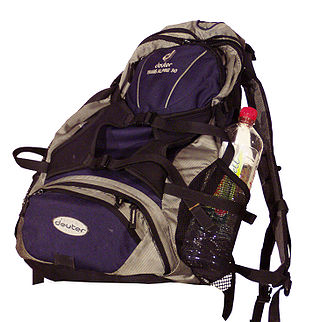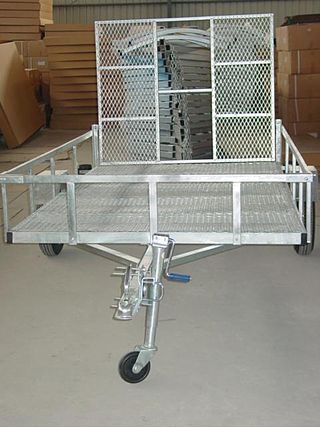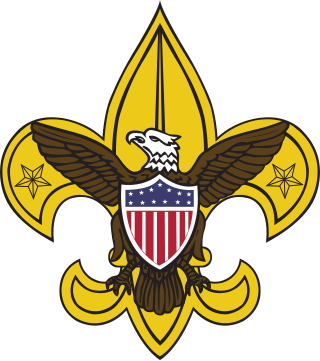
A kitchen is a room or part of a room used for cooking and food preparation in a dwelling or in a commercial establishment. A modern middle-class residential kitchen is typically equipped with a stove, a sink with hot and cold running water, a refrigerator, and worktops and kitchen cabinets arranged according to a modular design. Many households have a microwave oven, a dishwasher, and other electric appliances. The main functions of a kitchen are to store, prepare and cook food. The room or area may also be used for dining, entertaining and laundry. The design and construction of kitchens is a huge market all over the world.

A Scout is a child, usually 10–18 years of age, participating in the worldwide Scouting movement. Because of the large age and development span, many Scouting associations have split this age group into a junior and a senior section. Scouts are organized into troops averaging 20–30 Scouts under the guidance of one or more Scout Leaders or Scoutmasters. Troops subdivide into patrols of about 6–8 Scouts and engage in outdoor and special interest activities. Troops may affiliate with local, national, and international organizations. Some national Scouting associations have special interest programs such as Air Scouts, Sea Scouts, outdoor high adventure, Scouting bands, and rider Scouts.

A backpack—also called knapsack, rucksack, pack, booksack, bookbag, or backsack—is, in its simplest frameless form, a fabric sack carried on one's back and secured with two straps that go over the shoulders, but it can have an external frame, internal frame, and there are bodypacks.

Philmont Scout Ranch is a ranch located in Colfax County, New Mexico, near the village of Cimarron; it covers 140,177 acres (56,728 ha) of wilderness in the Sangre de Cristo Mountains on the east side of the Cimarron Range of the Rocky Mountains. Donated by oil baron Waite Phillips, the ranch is owned and operated by the Boy Scouts of America. It is a National High Adventure Base where crews of Scouts and Venturers take part in backpacking treks and other outdoor activities. By land area, it is one of the largest youth camps in the world. During the 2019 season, between June 8 and August 22, an estimated 24,000 Scouts and adult leaders backpacked through the Ranch's extensive backcountry. That same year 1,302 staff were responsible for the Ranch's summer operations.
In video gaming, camping is a tactic where a player obtains an advantageous static position, which may be a discreet place which is unlikely to be searched. The tactic is employed both in single-player games and online multiplayer games, but is usually more effective in an online multiplayer game, as AI opponents in single-player games may be aware of the player's position, even if they are visually hidden. The tactic varies depending on the type of game. In first-person shooters, it generally involves a player waiting in one location for other players to approach, then killing them before being noticed, or before the other players can react to their presence. By camping, a player is able to learn and adapt to the limited environment they are playing in, noting specific points to check repetitively. By following this method with little fault, a lower number of deaths can be achieved. In other cases, players may wait in an area to gain access to items or perform actions before other players who are not camping have the chance to do so.

Camping is a form of outdoor recreation or outdoor education involving overnight stays with a basic temporary shelter such as a tent. Camping can also include a recreational vehicle, sheltered cabins, a permanent tent, a shelter such as a bivy or tarp, or no shelter at all. Typically, participants leave developed areas to spend time outdoors, in pursuit of activities providing them enjoyment or an educational experience. Spending the night away from home distinguishes camping from day-tripping, picnicking, and other outdoor activities.

Outdoor cooking is the preparation of food in the outdoors. A significant body of techniques and specialized equipment exists for it, traditionally associated with nomadic cultures such as the Berbers of North Africa, the Arab Bedouins, the Plains Indians, pioneers in North America, and indigenous tribes in South America. These methods have been refined in modern times for use during recreational outdoors pursuits, by campers and backpackers.

A campervan, also referred to as a camper, caravanette, motorhome or RV in North America, is a self-propelled vehicle that provides both transport and sleeping accommodation. The term describes vans that have been fitted out, whereas a motorhome is one with a coachbuilt body.

The Greater St. Louis Area Council (GSLAC) of the Boy Scouts of America was formed in 1911 and is based in St. Louis, Missouri. The council serves Scouts in the St. Louis Metro area, southeast Missouri, and southern and central Illinois.

A trailer is an unpowered vehicle towed by a powered vehicle. It is commonly used for the transport of goods and materials.

A summer camp or sleepaway camp is a supervised program for children conducted during the summer months in some countries. Children and adolescents who attend summer camps are known as campers. Summer school is usually a part of the academic curriculum for a student to make up work not accomplished during the academic year.

Firecrafter is a service organization within the Boy Scouts of America. Formed in 1920, the Firecrafter Organization mainly operates within the Crossroads of America Council, Indiana, but has been known to exist in other areas including Illinois and Texas.

Camp Lazlo is an American animated television series created by Joe Murray for Cartoon Network. The series follows Lazlo, an anthropomorphic spider monkey who goes to a camp called "Camp Kidney", a Boy Scout–like summer camp in the Pimpleback Mountains. Lazlo resides in the "Jelly Bean" cabin with his fellow Bean Scouts; Raj, an Indian elephant, and Clam, a pygmy rhinoceros. Lazlo is often at odds with his pessimistic camp leader, Scoutmaster Lumpus, but usually gets along well with the second-in-command, Slinkman, and other campers. Camp Kidney sits just across the lake from Acorn Flats, which is home to the campsite of the all-female Squirrel Scouts. Camp Lazlo was one of the first Cartoon Network Studios series produced in a widescreen aspect ratio of 16:9, despite originally being broadcast in the full screen aspect ratio of 4:3.

Yawgoog Scout Reservation is a 1,800-acre (7 km2) reservation for scouting located in Rockville, Rhode Island and operated by the Narragansett Council of the Boy Scouts of America. Founded in 1916, Yawgoog is the fifth oldest Boy Scout camp in the United States. At the camp is run an eight-week camping program every summer where Boy Scouts stay for a week with their troops. The reservation is divided into three camps: Three Point, Medicine Bow, and Sandy Beach.

Scouts BSA is the flagship program and membership level of the Boy Scouts of America (BSA) for boys and girls between the ages of typically 11 and 17. It provides youth training in character, citizenship, and mental and personal fitness. Scouts are expected to develop personal religious values, learn the principles of American heritage and government, and acquire skills to become successful adults.

The Brownsea Island Scout camp was the site of a boys' camping event on Brownsea Island in Poole Harbour, southern England, organised by Lieutenant-General Baden-Powell to test his ideas for the book Scouting for Boys. Boys from different social backgrounds participated from 1 to 8 August 1907 in activities around camping, observation, woodcraft, chivalry, lifesaving and patriotism. The event is regarded as the origin of the worldwide Scout movement.

The Patriots' Path Council is a not-for-profit organization that establishes ideals in youth to help them make ethical choices by instilling values of good character, citizenship, personal fitness, and guidance. It serves members in the counties of Morris, Sussex, Somerset, Union, Hunterdon, and parts of Middlesex in New Jersey. It was established in 1999 with the merger of the Morris-Sussex Area Council (1936–1999) and the Watchung Area Council (1926–1999). On February 6, 2014, Patriots Path Council absorbed several Scouting units from the dissolved Central New Jersey Council (1999-2014).

The Mayflower Council of the Boy Scouts of America serves the MetroWest and southeastern regions of Massachusetts.

The Virginia Headwaters Council (VAHC) is the local council of the Boy Scouts of America (BSA) that serves Scouts in areas of the Shenandoah Valley in Virginia and West Virginia and areas of central Virginia.



















